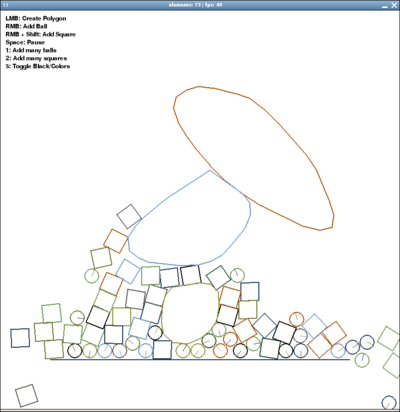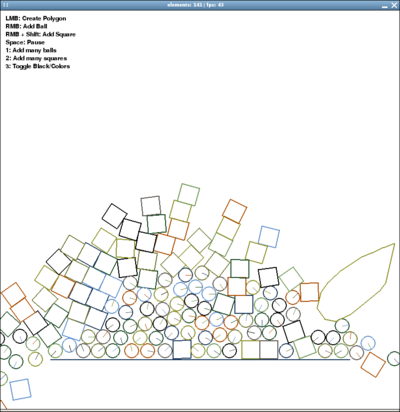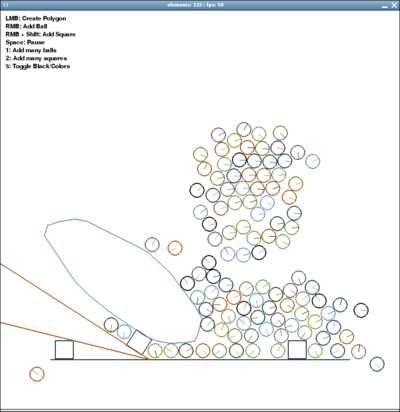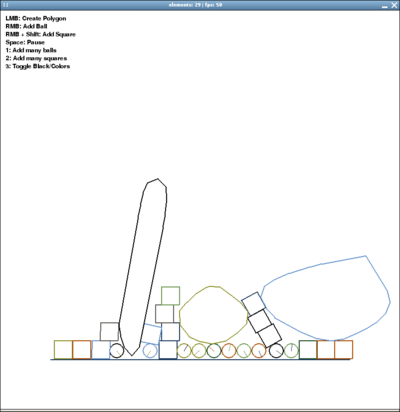Elements: Difference between revisions
Jump to navigation
Jump to search
Crazy-chris (talk | contribs) mNo edit summary |
Crazy-chris (talk | contribs) mNo edit summary |
||
| Line 22: | Line 22: | ||
* Communication to the chipmunk library is done via the pymunk ctypes bindings (by Victor Blomqvist.) |
* Communication to the chipmunk library is done via the pymunk ctypes bindings (by Victor Blomqvist.) |
||
* A lively and open development and support team is having fun improving and helping out :) |
* A lively and open development and support team is having fun improving and helping out :) |
||
* Features: ''fast, easy to use, segments, polygons, circles, colissions, variable gravity, density, mass, friction, elasticity, inertia, impulses, screenshots, screencasts, cross-platform, entertaining, fascinating, ...'' |
|||
* Limitations which will be implemented soon: Joints, Grouped Elements and Non-convex Polygons. Screencast encoding currently works only in linux with mencoder installed. |
|||
| Line 39: | Line 41: | ||
== |
== Documentations == |
||
* [[Elements/Documentation|Elements API Documentation]] |
|||
* [http://www.linuxuser.at/pymunx/pymunk_api Pymunk API] |
|||
* [http://files.slembcke.net/chipmunk/chipmunk-docs.html Chipmunk Docs] |
|||
Revision as of 18:02, 12 March 2008
About
The Elements project is all about free and easy 2D physics for python -- with main attention on:
- An easy-to-use, fast 2D physics API
- Examples and documentation on how to use the API
- Providing the examples as bundles, as they are already interesting and fun
- Speed optimization (also with an eye on the XO laptop :)
- Development of ideas for education and playful-learning
- Elements.zip | Elements.xo | Documentation | Examples | Screenshots | Videos
More Informations
- IRC: #elements on irc.freenode.net
- Project started by Chris Hager, March 2008. Source-Code is GPL licensed - so do with it what you want! Even eat it :)
- The Elements project derived from pymunx, which started as examples for pymunk and is growing up to a real physics api for python
- The 2D physics is handled by the chipmunk physics engine (written in C by ...)
- Communication to the chipmunk library is done via the pymunk ctypes bindings (by Victor Blomqvist.)
- A lively and open development and support team is having fun improving and helping out :)
- Features: fast, easy to use, segments, polygons, circles, colissions, variable gravity, density, mass, friction, elasticity, inertia, impulses, screenshots, screencasts, cross-platform, entertaining, fascinating, ...
- Limitations which will be implemented soon: Joints, Grouped Elements and Non-convex Polygons. Screencast encoding currently works only in linux with mencoder installed.
Screenshots
(from Elements/Screenshots)
Downloads
- Elements_latest.zip ... Libs and examples to get started
- File:Elements latest.xo ... Packed for the XO Laptop
- svn checkout http://pymunk.googlecode.com/svn/trunk/ pymunk-read-only ... Pymunk with demos and docs
- ChipmunkLatest.tgz ... The source of the Chipmunk physics engine (written in C)
Documentations




